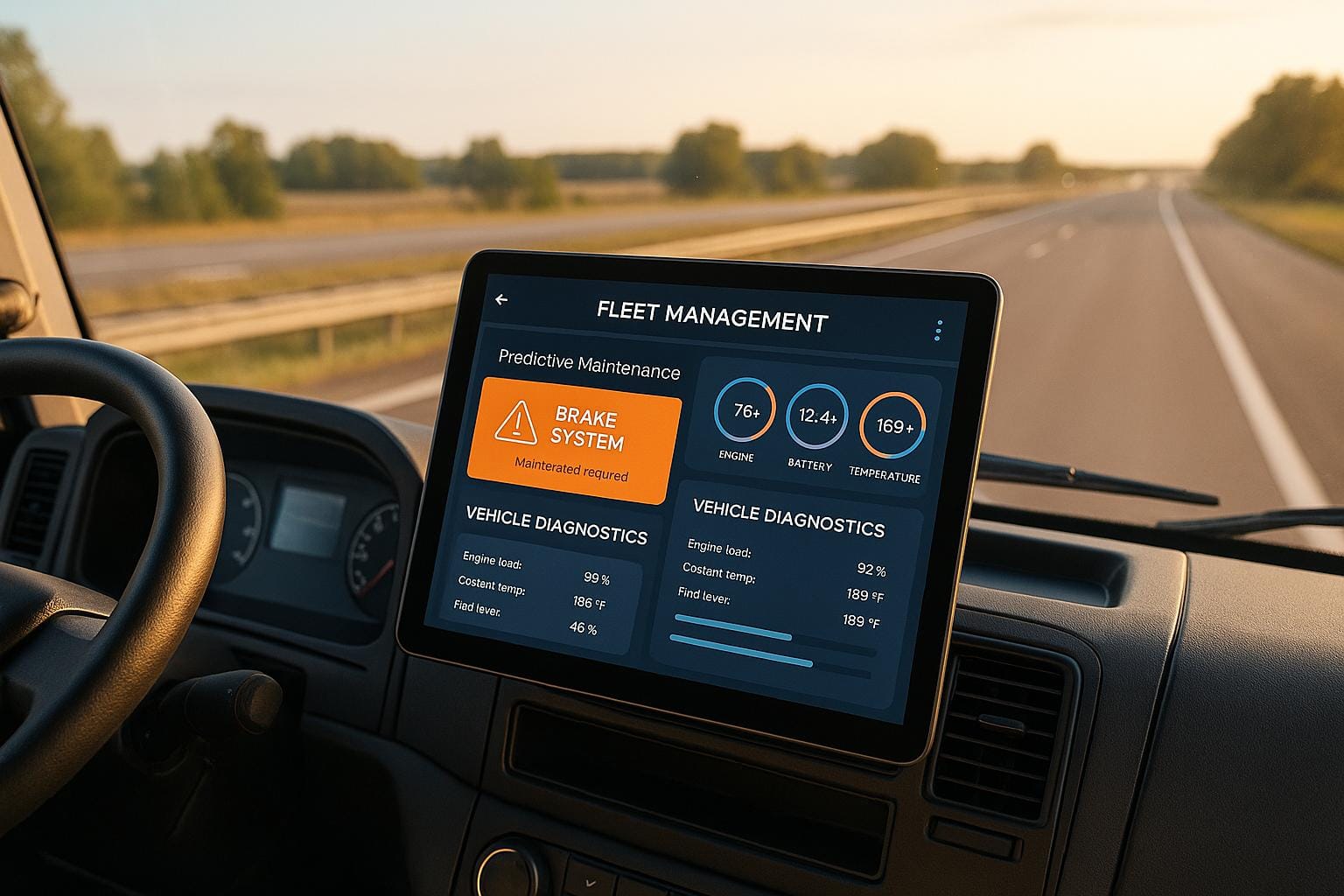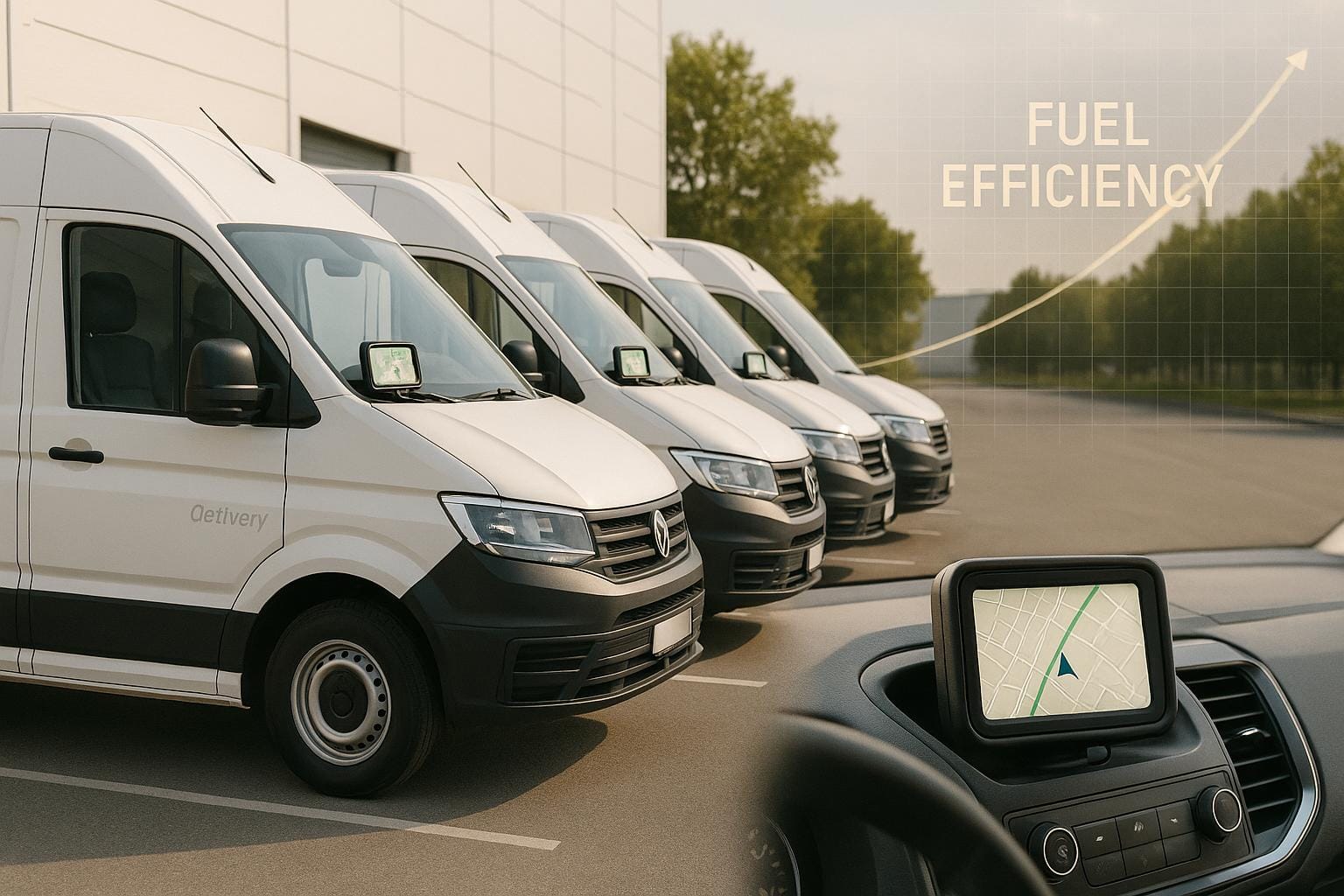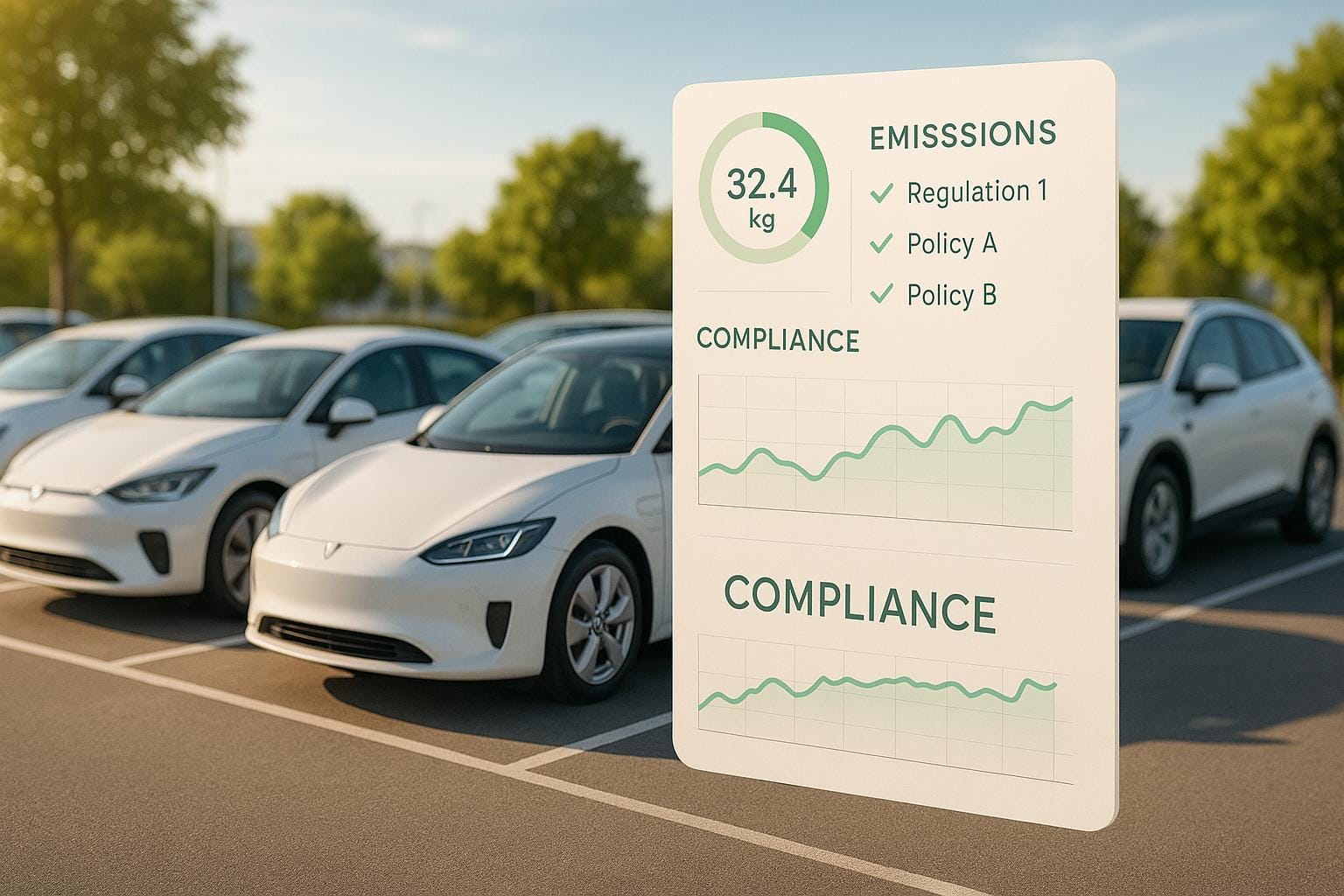Remote vehicle immobilisation is a telematics feature that lets fleet managers disable a vehicle remotely, preventing it from starting after the engine is turned off. With over 133,000 vehicle thefts in the UK in 2023–24, this technology helps protect fleets while improving operational control. Here's what you need to know:
- How It Works: Uses GPS tracking and cellular networks to monitor and control vehicles in real time. Immobilisation is triggered manually or automatically and only activates when the vehicle is stationary and safe.
- Benefits: Prevents theft, reduces unauthorised use, increases recovery rates (up to 71%), lowers insurance premiums, and enhances fleet management.
- Components:
- Hardware: GPS trackers, starter interruption relays, dual-tracker setups, and anti-jamming features.
- Software: Real-time tracking, geofencing, safety checks, and role-based access controls.
- Safety and Compliance: Systems ensure immobilisation occurs only when safe, adhering to UK laws like GDPR and the Human Rights Act.
With theft prevention, cost savings, and better fleet control, remote immobilisation is a game-changer for modern fleet management.
How to Use Immobilisation - Fleet
Components Required for Remote Immobilisation Systems
Remote immobilisation systems are built on a combination of reliable hardware and intelligent software. These components work together to provide fleet operators with a dependable solution for managing vehicle security and operations.
Hardware Requirements
The hardware forms the physical foundation of any remote immobilisation system. Key components include GPS trackers equipped with customisable switched-ground outputs. These outputs control a relay system that can cut the starter motor, effectively preventing the vehicle from starting.
Modern systems often use two-stage immobilisers, which allow the engine to shut down safely without stalling, ensuring smoother operation. Starter interruption relays, frequently connected via OBD-II ports, not only enhance immobilisation functionality but also provide access to valuable vehicle data. To prevent accidental shutdowns caused by tracker malfunctions, these systems are typically designed to "fail safe" - meaning the engine remains operational if the tracker fails.
For added reliability, redundancy is highly recommended. Many fleet operators install two tracking units: a visible primary unit and a hidden secondary unit. The latter serves as a backup, activating if the primary tracker is tampered with or disabled. This dual-tracker setup significantly improves system dependability and deters tampering attempts.
To counteract interference, advanced systems incorporate anti-jamming features. These include concealed, hard-wired components and anti-tamper alerts, which help protect against GPS and GSM signal disruptions. Together, these hardware measures ensure the system remains secure and operational under various conditions.
Software Features
While hardware provides the foundation, the software is the brain behind the system, enabling safe and effective immobilisation. Real-time GPS tracking monitors vehicle speed and location, ensuring that immobilisation is executed only when conditions are safe. Geofencing tools allow fleet managers to set virtual boundaries and receive alerts when vehicles enter or leave specific zones. Additionally, role-based access control ensures that only authorised personnel can activate immobilisation features, adding an extra layer of security.
The system relies on data from multiple sensors, including GPS, OBD-II, and IMU (Inertial Measurement Unit), to guide immobilisation decisions. These sensors provide critical information - such as engine RPM, gear position, brake status, and motion detection - ensuring immobilisation occurs under safe conditions. For example, advanced software can queue immobilisation commands until the vehicle is stationary, reducing risks during execution.
Historical data is another crucial feature. It allows fleet managers to review past events, investigate incidents, and confirm compliance with safety standards. Additionally, the software provides confirmation that immobilisation commands have been received and successfully executed, giving operators confidence in the system's performance.
API integration takes functionality to the next level, allowing the immobilisation system to seamlessly connect with other fleet management tools and security protocols. This integration streamlines workflows and ensures the system operates as part of a broader, cohesive fleet management strategy. Together, these software features ensure that remote immobilisation is not only effective but also safe and easy to manage in critical situations.
How Remote Immobilisation Works: Step-by-Step Process
Remote immobilisation takes the telematics security framework to the next level, turning real-time monitoring into a proactive tool for protecting vehicles. By breaking down how this system works, fleet operators can better understand its strengths and limitations. The process involves verifying threats, conducting safety checks, and executing commands carefully to ensure vehicles are disabled securely, without endangering drivers or violating legal standards.
Threat Detection and Safety Checks
Modern telematics systems are constantly monitoring vehicles through real-time GPS tracking and algorithms designed to recognise typical driving patterns. When a vehicle behaves unusually - such as breaching a geofence, moving without authorisation, or experiencing GSM jamming - the system sends an alert right away.
AI-powered cameras add another layer of security by spotting suspicious behaviour, even when vehicles are parked. These cameras learn normal driver habits and cross-check this data with GPS to flag anything out of the ordinary. Additionally, driver authentication systems ensure that only authorised personnel can start the engine.
The results speak for themselves: businesses using GPS tracking report stolen vehicle recovery rates as high as 71%. A survey also revealed that 44% of fleet operators are aware of ongoing fuel fraud within their operations. Before any immobilisation command is issued, the system conducts vital safety checks - monitoring the vehicle’s speed, location, and status to confirm it’s safe to proceed.
Once the threat is verified and safety conditions are met, the system moves forward with sending the immobilisation command.
Sending the Immobilisation Command
After confirming a threat, the immobilisation process follows a structured approach. This includes verifying the situation, working with UK law enforcement, choosing the right time and place, selecting the appropriate method, and planning for vehicle recovery.
For instance, Sarah, a fleet manager in Manchester, suspected theft when a delivery van didn’t return after hours. She alerted Greater Manchester Police and her company’s security team. Once the van stopped at a roundabout, she remotely disabled the engine. The police were then able to apprehend the thieves without incident.
The immobilisation command is securely transmitted via GPRS or SMS to the vehicle’s telematics unit. To ensure security, only authorised personnel with proper authentication can activate this feature. Once the command reaches the vehicle, it waits in a queue until it’s safe to execute.
Collaboration with law enforcement is crucial. Fleet managers must ensure that a vehicle is genuinely being stolen or misused before using the immobilisation feature. In cases of misuse, it’s also wise to warn the driver before taking action.
Safety Measures and UK Compliance
Safety is the top priority throughout the immobilisation process. Modern systems ensure that while the command can be sent when the vehicle is moving, the engine will only be disabled once the vehicle is stationary and the ignition is off. This prevents any dangerous situations caused by a sudden engine shutdown.
Two-stage immobilisers add another layer of protection by stopping the engine from restarting rather than abruptly cutting it off. Fleet managers are encouraged to wait for the safest possible moment - such as when a vehicle is idling at a traffic light, stuck in traffic, or parked - before executing immobilisation commands.
UK regulations introduce additional requirements for remote immobilisation systems. The Human Rights Act 1998 and General Data Protection Regulation (GDPR) govern vehicle tracking. Employers must inform drivers about tracking, and for vehicles used outside work hours, they must allow drivers to disable tracking during personal use.
Under GDPR, location data must be tightly safeguarded. Employers are required to clearly explain why data is being collected, limit data collection to legitimate business needs, and use encryption and access controls to protect it. Drivers must give explicit written consent and have the right to access their data upon request.
To ensure compliance, modern systems restrict access to immobilisation features to authorised Admin users, maintaining strict access controls while adhering to UK legal standards.
Practical Uses and Benefits for Fleet Operators
Remote immobilisation has transformed fleet security by shifting the focus from reactive measures to proactive strategies. It not only safeguards vehicles but also simplifies fleet operations. Integrated seamlessly with broader fleet management systems, it ensures operators maintain consistent control over their assets.
Theft Prevention and Vehicle Recovery
Combining dual-tracker technology with remote immobilisation offers a robust defence against theft. If one tracking device is disabled, the secondary system remains active, allowing continuous monitoring and the ability to send immobilisation commands. GRS Fleet Telematics reports an impressive 91% recovery rate thanks to this dual-tracker setup.
Take the example of Andy Pears, Welding Manager at Weld-A-Rail, who faced two vehicle thefts in just three days. Using his fleet tracking system, both vehicles were located only two miles away, enabling swift police recovery.
Geofencing adds another layer of security. When a vehicle crosses preset boundaries, the system immediately alerts fleet managers. They can then assess the situation and, if needed, immobilise the vehicle. This feature is particularly useful for preventing unauthorised use, such as rental customers exceeding agreed travel zones.
Insurance companies often recognise the reduced theft risks associated with telematics systems featuring remote immobilisation. As a result, fleet operators may qualify for lower premiums, helping to balance the system’s costs while enhancing security.
For rental businesses, the technology proves invaluable in cases of payment defaults or fraudulent bookings. Operators can safely disable vehicles when payments are overdue or when customers fail to return them.
Beyond theft prevention, remote immobilisation also plays a key role in improving operational oversight and maintenance management.
Fleet Control and Maintenance Management
Remote immobilisation is a powerful tool for maintaining operational control. For instance, fleet managers can prevent vehicles from being used until they pass mandatory inspections, MOTs, or other maintenance tasks, ensuring compliance with safety standards. This approach not only reduces liability risks but also keeps vehicles roadworthy.
By enforcing scheduled maintenance and preventing unauthorised trips, companies can cut fuel costs and extend vehicle lifespans. Immobilising overdue vehicles helps avoid costly breakdowns and ensures smoother operations.
In 2023, Fleet News reported that UK companies using telematics for maintenance management saw a 30% drop in unscheduled repairs. A courier service in Canterbury also reported a 35% decrease in at-fault accidents within six months of implementing driver behaviour monitoring through their fleet tracking system.
Similarly, a logistics firm in Ashford achieved an 18% reduction in fuel costs and a 30% improvement in delivery punctuality by adopting advanced fleet tracking systems. Remote immobilisation prevents unnecessary mileage and fuel wastage by stopping unauthorised journeys before they start.
It also aids compliance monitoring by ensuring non-compliant vehicles - those with expired insurance, overdue inspections, or unlicensed drivers - are immobilised until the issues are resolved. This helps fleets avoid fines and operational disruptions.
To maximise the effectiveness of these systems, fleet managers should conduct regular maintenance checks and software updates. Training programmes for authorised personnel are equally important, covering legal requirements, technical operations, and emergency protocols. This ensures the technology is used safely and effectively, delivering its full range of benefits.
Conclusion: Fleet Security Through Telematics Technology
Fleet security is evolving, and telematics technology is leading the charge. By shifting from a reactive to a proactive approach, telematics-based remote immobilisation offers a robust way to protect assets while keeping operations seamless. The combination of GPS tracking, geofencing, and controlled immobilisation creates a multi-layered solution that bolsters security without compromising efficiency.
Telematics systems are designed to activate immobilisation only when vehicles are stationary, ensuring safety while safeguarding assets. This thoughtful approach gives fleet managers the tools to act decisively and responsibly.
One standout example is GRS Fleet Telematics, which demonstrates the potential of this technology with its dual-tracker system and comprehensive security features. Their Ultimate package, priced at £99 for hardware and a £7.99 monthly subscription, includes full immobilisation and dual tracking. This dual-tracker system has achieved an impressive 91% recovery rate, as previously highlighted.
With a vehicle stolen every five minutes in the UK, the importance of remote immobilisation cannot be overstated. Insurers are also recognising the value of these systems, often offering reduced premiums for fleets equipped with advanced security measures.
Beyond theft prevention, telematics systems are proving indispensable for broader fleet management. They can immobilise vehicles until required safety checks are completed or prevent unauthorised use during off-hours. This versatility means telematics not only secures vehicles but also supports compliance, maintenance scheduling, and cost management.
FAQs
How does remote immobilisation improve fleet safety and ensure compliance?
Remote immobilisation is a game-changer for fleet safety and compliance. It allows fleet managers to remotely deactivate vehicles in cases of theft or unauthorised use, acting as a strong deterrent against criminal activity. This ensures vehicles are used strictly according to company policies, boosting security and potentially lowering insurance premiums.
On top of that, telematics systems equipped with remote immobilisation offer real-time tracking and monitoring capabilities. This means fleet managers can keep a close eye on operations while maintaining detailed records of vehicle usage. These records are invaluable for audits and regulatory checks, helping businesses stay compliant and avoid hefty fines. Altogether, these tools make fleet management safer and more efficient.
What hardware and software are needed to set up a reliable remote immobilisation system?
To set up a dependable remote immobilisation system, you'll need a few essential hardware components. This includes GPS tracking devices for location monitoring, relay modules to manage the vehicle's starter motor, and communication interfaces like GSM or LTE to handle remote commands effectively.
On the software front, a strong vehicle management platform is crucial for overseeing operations and ensuring control. Pair this with an intuitive mobile app or web interface to provide easy access for users. More advanced systems might also offer features like driver ID verification and instant alerts for any unauthorised vehicle movements. Together, these elements boost vehicle security while simplifying fleet management.
How does remote immobilisation help reduce costs and improve fleet management efficiency?
Remote immobilisation is a game-changer for cutting costs and improving fleet management. By allowing fleet managers to disable vehicles remotely, it acts as a strong deterrent against theft and helps recover stolen vehicles quickly. This not only protects valuable assets but can also result in reduced financial losses and potentially lower insurance premiums.
On top of that, telematics systems equipped with immobilisation features offer real-time data on vehicle performance and usage. This means maintenance can be planned proactively, preventing unexpected breakdowns and avoiding unnecessary repairs. By keeping vehicles in top shape and servicing them at the right time, businesses can streamline operations and keep running costs under control.




